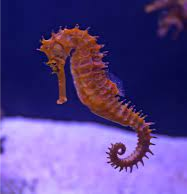Important Facts For Prelims
Great Seahorse Migration
- 06 Mar 2023
- 5 min read
Why in News?
A study indicated that extensive fishing off the Coromandel coast could be forcing the great seahorse to migrate towards Odisha.
- Though, fishing is less intense off the Odisha coastline but still it may not be the new comfort zone for the Seahorse due to lack of suitable habitat.
What are the Key Facts about Seahorse?
- About:
- Sea horses are tiny fish that are named for the shape of their head, which looks like the head of a tiny horse. They are classified as fish, in the genus Hippocampus.
- There are 46 species of seahorses reported worldwide. The coastal ecosystems of India house 9 out of 12 species found in the Indo-Pacific.
- They are found in shallow coastal waters in latitudes from about 52° N to 45°S.

- Seahorse populations in India are distributed across diverse ecosystems such as seagrass, mangroves, macroalgal beds, and coral reefs.
- Distribution in India:
- These 9 species are distributed along the coasts of eight States and five Union Territories from Gujarat to Odisha, apart from Lakshadweep and the Andaman and Nicobar Islands.
- Slow Swimmers:
- When swimming they maintain a vertical position and propel themselves forward using a soft-rayed dorsal fin.
- They migrate by rafting, clinging to floating substrata such as macroalgae or plastic debris for dispersal by ocean currents.
- Unique Reproductive Habits:
- The male gives birth to child as the female uses an ovipositor (egg duct) to place her eggs into a brood pouch located at the base of the male’s tail where the eggs are later fertilized.
- Conservation Status:
- IUCN status-Vulnerable
- CITES: Appendix II
What are the Reasons for Decline and Migration?
- The population of the Great seahorse is declining due to its Overexploitation for
- Traditional Chinese medicines
- Ornamental fish
- General destructive fishing
- Fisheries bycatch.
- This creates immense pressure on the seahorse populations that have a high dependency on local habitats to maintain their extensive and long-life history traits.
- The 1,300 km northward migration of the great seahorse from Palk Bay and the Gulf of Mannar to Odisha is likely a response to extensive fishing activities around the southern coast of India.
- Around 13 million individuals are caught per year on Coromandel coast.
What are the Challenges with Migration?
- Lack of Suitable Habitats: Odisha coast does not have coral reefs or seagrass meadows to make a suitable habitat, except within the Chilika region.
- Thus, it is going to be difficult for the species, unless the fishing nets that catch them are banned or the fishing practices such as Bottom trawling are stopped.
- Lack of Conservation Measures: This highlights the lack of monitoring of the coastal ecosystems of India on the east coast and reaffirms the need better conservation and management of the remaining seahorse populations.
UPSC Civil Services Exam, Previous Year Questions (PYQ)
Q. Consider the following animals: (2013)
- Sea cow
- Sea horse
- Sea lion
Which of the above is/are mammal/mammals?
(a) 1 only
(b) 1 and 3 only
(c) 2 and 3 only
(d) 1, 2 and 3
Ans: (b)
Exp:
- Sea cow is a sea-grass eating marine mammal which is found in the Indian Ocean on the western part of the Pacific Ocean. They are the only extant species of the family “Dugongidae”. Hence, 1 is correct.
- Sea horses are tiny fish that are named for the shape of their head, which looks like the head of a tiny horse. Sea horses are not mammals as they are classified as fish, in the “genus Hippocampus”. Hence, 2 is not correct.
- Sea lions are the marine or aquatic mammals as they give live births, breathes air, and suckles its young with milk like all other mammals. They are found primarily in the Pacific waters. Hence, 3 is correct.
- Therefore, option (b) is the correct answer.






